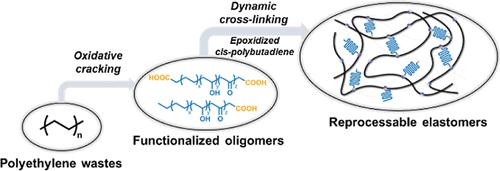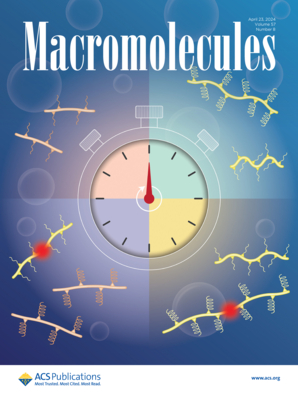将聚烯烃废料氧化升级再循环为动态交联弹性体
IF 5.1
1区 化学
Q1 POLYMER SCIENCE
引用次数: 0
摘要
将聚烯烃氧化裂解成功能化分子或低聚物有望实现塑料废物的化学升级再循环。在这项工作中,我们开发了一种新的聚烯烃废物升级再循环方法,利用低温氧化裂解结合动态交联来生产可回收的弹性体。高密度聚乙烯在 110 °C 下被氧化成带有末端羧基的官能化低聚物,在分布 (D̵) 介于 2.91 和 3.33 之间时,可获得 1500 到 5500 Da 的可调数均分子量 (Mn)。这些具有高结晶度的低聚物通过酯化作用直接与含有悬垂环氧基团(顺式聚丁二烯的氧化产物)的无定形顺式聚丁二烯发生反应,形成动态交联弹性体。这种弹性体的玻璃化转变温度(Tg)较低,约为 -100 °C,同时熔点(Tm)保持在 80 °C 以上;它的杨氏模量(E)为 12.0 ± 0.4 MPa,断裂伸长率(ε)为 600 ± 28%,拉伸强度(σ)为 16.拉伸强度(σ)为 16.4 ± 0.8 MPa,拉伸韧性(UT)为 46.0 ± 3.5 MJ-m-3,弹性良好,在 10 周期拉伸试验中的弹性恢复率为 81.8%,甚至高于陶氏公司的 POE-8150 等商用 POE。基于动态酯键的交联使这种弹性体可以进行再加工。我们的研究为聚烯烃废料引入了一种高效的化学升级再循环工艺,省去了繁琐的裂解产品分离步骤。本文章由计算机程序翻译,如有差异,请以英文原文为准。

Oxidative Upcycling of Polyolefin Wastes into the Dynamically Cross-Linked Elastomer
Oxidative cracking of polyolefins into functionalized molecules or oligomers promises the chemical upcycling of plastic wastes. In this work, we develop a novel approach to polyolefin waste upcycling that utilizes low-temperature oxidative cracking combined with dynamic cross-linking to produce recyclable elastomers. High-density polyethylene is oxidized into functionalized oligomers with end carboxyl groups at 110 °C, achieving tunable number-average molecular weights (Mn) ranging from 1500 to 5500 Da at distributions (D̵) between 2.91 and 3.33. These oligomers with high crystallinity directly react with amorphous cis-polybutadiene containing pendant epoxy groups (an oxidized product of cis-polybutadiene) through esterification, forming a dynamically cross-linked elastomer. The elastomer displays a low glass transition temperature (Tg) of approximately −100 °C while maintaining a melting point (Tm) above 80 °C; it showcases a Young′s modulus (E) of 12.0 ± 0.4 MPa, elongation at break (ε) of 600 ± 28%, tensile strength (σ) of 16.4 ± 0.8 MPa, tensile toughness (UT) of 46.0 ± 3.5 MJ·m–3, and a good elasticity with 81.8% elastic recovery in a 10-cycle tensile test, even higher than that of commercial POEs such as POE-8150 of Dow Company. The dynamic ester-bond-based cross-linking enables the elastomer to be reprocessed. Our study introduces an efficient chemical upcycling process for polyolefin wastes, eliminating the need for tedious separation steps of cracking products.
求助全文
通过发布文献求助,成功后即可免费获取论文全文。
去求助
来源期刊

Macromolecules
工程技术-高分子科学
CiteScore
9.30
自引率
16.40%
发文量
942
审稿时长
2 months
期刊介绍:
Macromolecules publishes original, fundamental, and impactful research on all aspects of polymer science. Topics of interest include synthesis (e.g., controlled polymerizations, polymerization catalysis, post polymerization modification, new monomer structures and polymer architectures, and polymerization mechanisms/kinetics analysis); phase behavior, thermodynamics, dynamic, and ordering/disordering phenomena (e.g., self-assembly, gelation, crystallization, solution/melt/solid-state characteristics); structure and properties (e.g., mechanical and rheological properties, surface/interfacial characteristics, electronic and transport properties); new state of the art characterization (e.g., spectroscopy, scattering, microscopy, rheology), simulation (e.g., Monte Carlo, molecular dynamics, multi-scale/coarse-grained modeling), and theoretical methods. Renewable/sustainable polymers, polymer networks, responsive polymers, electro-, magneto- and opto-active macromolecules, inorganic polymers, charge-transporting polymers (ion-containing, semiconducting, and conducting), nanostructured polymers, and polymer composites are also of interest. Typical papers published in Macromolecules showcase important and innovative concepts, experimental methods/observations, and theoretical/computational approaches that demonstrate a fundamental advance in the understanding of polymers.
 求助内容:
求助内容: 应助结果提醒方式:
应助结果提醒方式:


